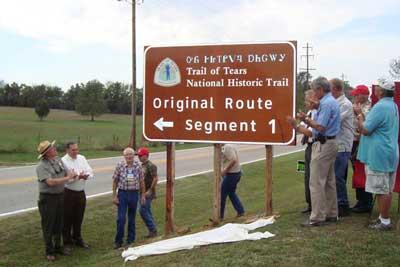In 1838, the United States government forcibly removed more than 16,000 Cherokee Indian people from their homelands in Tennessee, Alabama, North Carolina, and Georgia, and sent them to Indian Territory—a place we now call Oklahoma. Both the route they followed and the experience itself are known as the Trail of Tears, and they are commemorated by The Trail of Tears National Historic Trail.
The Trail covers thousands of miles of land and water routes in parts of nine states (Alabama, Arkansas, Georgia, Illinois, Kentucky, Missouri, North Carolina, Oklahoma and Tennessee) and "was designated to preserve the story, the routes, and support the associated sites that commemorate the Cherokees' forced migration." Much of the Trail of Tears National Historic Trail is on waterways. People were moved onto boats and traveled along the Mississippi River, and then disembarked and walked.
The Trail of Tears National Historic Trail isn't a single, contiguous route managed by a one agency, but a cooperative effort by number of federal, state and local agencies, organizations, tribes, and private individuals to administer sites that are either along the original route or which have exhibits or other information about the migration.
The National Park Service's National Trails Intermountain Region staff helps plan and coordinate efforts by a wide variety of partners to create Trail of Tears retracement hiking trails, signage and exhibits. Representatives from the Cherokee Nation, The Nature Conservancy, the Trail of Tears Association, the National Park Service and the public came together recently in western Kentucky and southern Illinois to remember the original events and celebrate progress in developing the National Historic Trail.
At Mantle Rock Preserve in Livingston County, Kentucky, The Nature Conservancy unveiled its new retracement hiking trail as well as the new wayside exhibits. Both of these were completed in partnership with the National Park Service. Visitors can walk more than a mile of the same historic road that the Cherokee walked and camped along in 1838.
Over 10,000 Cherokee came through this area during the winter, when frozen rivers and extreme cold trapped many of the Cherokee in the Mantle Rock vicinity. The exhibits feature original watercolor paintings by National Trails Intermountain Region Interpretive Specialist Cookie Ballou, that visually tell the story of removal. Several of the exhibits also feature the natural wonders of prairie, woodland, and glade protected at Mantle Rock Preserve.
In Pope County, Illinois, officials and members of the public celebrated a sign unveiling event that will help the public to visit original route segments of the Trail of Tears. Although many of the original roads along the 800-mile route of the Trail of Tears have disappeared, there are places along the historic route like the 8.5 miles of historic road in Pope County that have survived, allowing visitors to retrace and remember this tragic event in our nation’s history. The Pope County project is a prototype for ongoing efforts across the entire length of the trail to sign the roads that are the surviving original route of the Trail of Tears.
Featured guests and speakers at the events included Principal Chief of the Cherokee Nation Chad Smith and the First Lady Bobbie Gail, Deputy Chief Joe Grayson, Jr., Cherokee Nation Supreme Court Judge Troy Wayne Poteete, Trail of Tears Association President and Tribal Council Member Jack Baker, a representative from the Kentucky governor’s office and the local congressman’s office, a state representative, Department of Transportation officials, and other local officials.
Principal Chief Smith, interviewed by media at the Pope County unveiling, remarked that the new signs and exhibits play a major role in increasing awareness of the Trail of Tears experience. He stated that “What this monument does is not only reflect that there were a people here, but that they were a real people, and they are being remembered.”
Like to learn more, or visit some of these locations? The Trail's website includes information, organized by state, about a number of locations associated with the Trail of Tears National Historic Trail.


 Support Essential Coverage of Essential Places
Support Essential Coverage of Essential Places







Comments
Enlighten me....who was responsible for that march?
The Trail of Tears was a result of the Indian Removal Act of 1830. President Andrew Jackson was the 1st to use the Act to forcibly remove Native Americans from their homeland. Martin Van Buren ordered further removals. The actual removals were done by the U S military under the auspices of the Secretary of War, Lewis Cass.
The Cherokee were not the only tribe forcibly removed from their homelands. Also moved under this abominable Act were the Chickasaw, Choctaw, Seminole, and Musgogee-Creek. Each of these tribes has it's own 'Trail of Tears'.
As a proud Native American, I won't start in about the U S Govt's treatment of Native Peoples. Read "Bury My Heart at Wounded Knee" by Dee Brown.
You can also read Century of Dishonor by Helen Hunt Jackson, published in 1882. She wrote this scathing documentary about the attrocities on Native Americans at the hand of the US Government in the 1860s -1870s, and sent a copy of it to each member of Congress. She was so passionate about highlighting the plight of Native Americans in the US that she ultimately became an agent for the Bureau of Indian Affairs and was sent to Southern California to record Native American experiences. Unfortunately Century of Dishonor was not very popular with the government or the public so it didn't have the impact that she had hoped in recognizing Native American issues. Seeing that, she decided to write and publish the novel Ramona. She hoped that Ramona would have the same impact for Native American issues as Uncle Tom's Cabin had for Harriet Beecher Stowe. Unfortunately that wasn't the case....the book has become more popular for the romanticized image of Southern California in the 1860s.